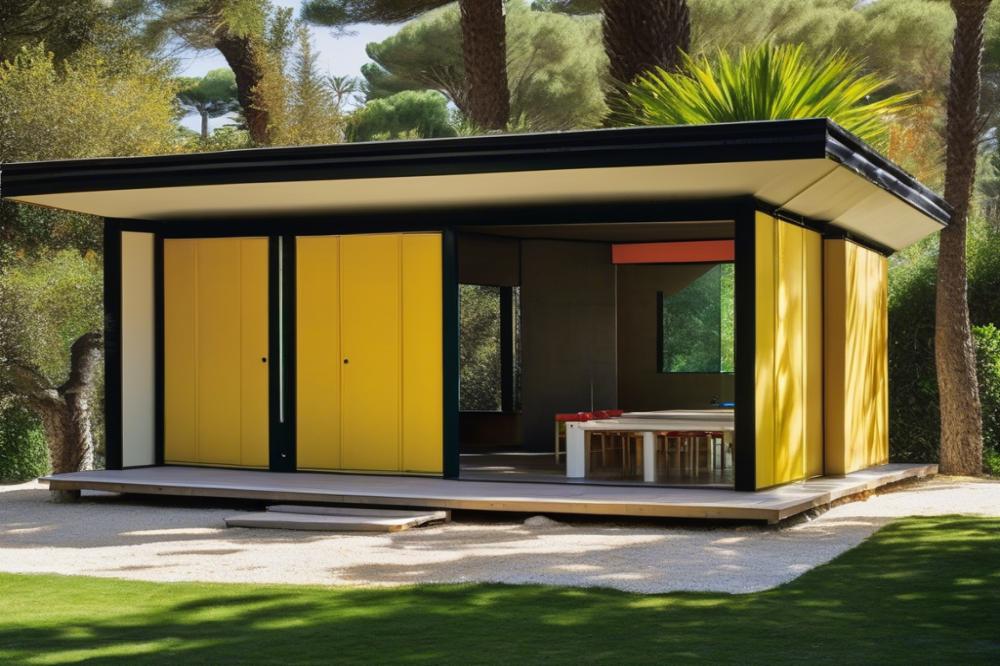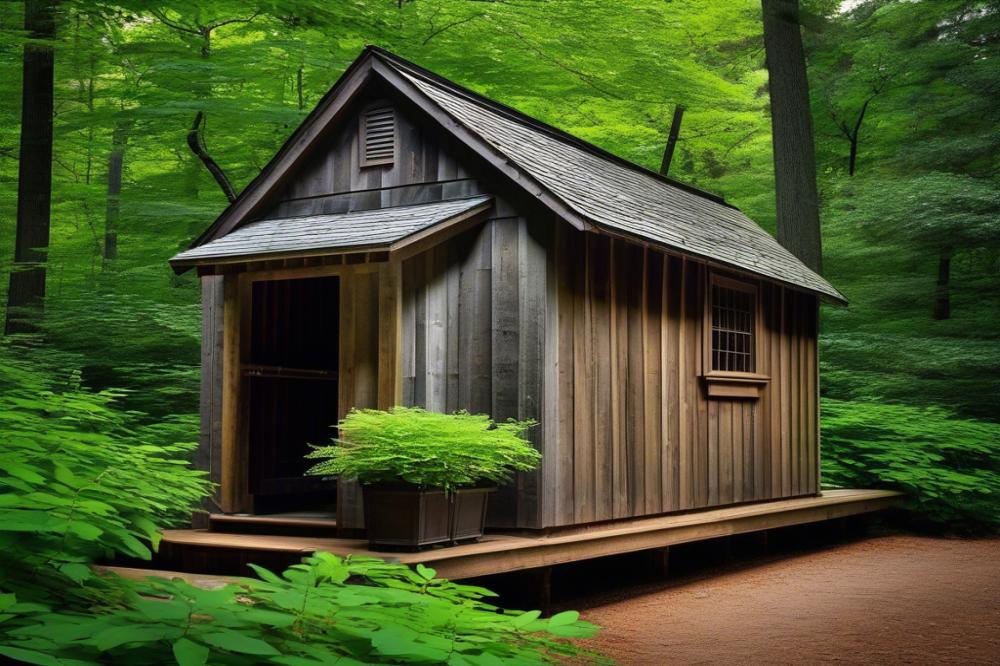Overview of the Cabanon Shed
The Cabanon Shed stands as a striking example of modernist architecture on the stunning French Riviera. Designed by the influential architect Le Corbusier, this structure is more than just a vacation home. It embodies a philosophy that emphasizes simplicity and functionality in design.
Minimalism plays a vital role in this creation. Each aspect of the shed reflects a commitment to essential living, stripped of unnecessary embellishments. Its modest dimensions house all the necessities in a compact form that enhances the surrounding landscape.
Modernism reshaped ideas about space and function in the mid-20th century. This shed contributes to that conversation by showing how a small space can serve numerous purposes. It’s not just a building; it tells a story about the era and an artistic vision.
Throughout the world, famous sheds have captured imaginations, but few resonate as deeply as this one. Its historical significance cannot be overstated. The connection between architecture and art is vividly evident in the design of the Cabanon Shed. It invites viewers to reflect on how buildings can harmonize with their environments.
In essence, this unique structure represents more than just innovative construction. It serves as a testament to Le Corbusier‘s enduring impact on modern architecture. The Cabanon is a charming reminder of how design can speak to both functionality and aesthetics.
The Design and Construction of the Cabanon Shed

The Cabanon Shed, nestled on the French Riviera, showcases the architectural vision of Le Corbusier. Designed as a simple vacation home, it reflects the core principles of modernism. Minimalism is at the heart of this structure, revealing a deep connection between function and form. Every element serves a purpose, demonstrating that less truly can be more.
Made from local materials, the construction emphasizes a harmony with the surrounding landscape. The walls are a mix of concrete and wood, offering durability while maintaining an organic feel. By choosing materials that blend with nature, Le Corbusier enhances the building’s aesthetic. Large windows invite natural light inside, creating a seamless transition between indoor and outdoor spaces.
Architecture lovers will notice the thoughtful proportions of the Cabanon Shed. Its small size does not diminish its impact; rather, it shows how simplicity can make a profound statement. The design features cleverly arranged spaces, enabling efficient use without feeling cramped. Every corner whispers elegance, while the overall structure retains a humble presence.
Art and architecture converge in this unique vacation retreat. Its historical significance cannot be understated, as it represents a turning point in the evolution of residential design. Visitors often find themselves curious about the inspiration behind such a remarkable creation. That curiosity often leads to a deeper appreciation for minimalist principles and their role in contemporary architecture.
The Cabanon Shed serves as a reminder of how architecture can influence our lives. It stands as an example of how thoughtful design can harmonize with its environment. People often cherish the tranquility it offers, feeling at home amidst the stunning landscapes of the French Riviera. Le Corbusier’s work continues to inspire future generations of architects and designers alike.
Historical Significance and Cultural Context

The Cabanon Shed was constructed in the summer of 1951 on the stunning French Riviera. This small structure reflects the broader historical context of post-World War II architecture. During this time, designers were exploring new ideas. Modernism in architecture gained traction, aiming for a break from traditional forms.
Le Corbusier, a key figure in this movement, believed in functionality and simplicity. His philosophies reshaped how buildings were designed. The minimalist approach he championed became influential in various design movements worldwide. Architects started to see the value of space and light, changing how people interacted with their environments.
The shed served as a vacation home for Le Corbusier. Its location allowed him to connect deeply with the surrounding landscape. Nestled among nature, the structure exemplifies harmony between man-made and natural elements. This connection enhances the experience of the setting and highlights the importance of place.
Inside the shed, one can find a focus on essential living. Every inch is thoughtfully used, reflecting Le Corbusier’s belief in efficient design. Art and construction merge seamlessly in this space. It tells a story, not just of a structure, but of a new way of thinking about architecture and life.
Through its design, the Cabanon Shed represents more than just a vacation getaway. It stands as a historic landmark that showcases Le Corbusier’s innovative spirit. Visitors often feel a strong sense of creativity when exploring this architectural gem. Its significance continues to resonate, influencing generations as they strive for balance in design and nature.
The Cabanon Shed and Modernist Architecture

The Cabanon Shed stands out as a remarkable example of modernist architecture on the French Riviera. This humble structure reflects the design principles that define the movement. Simplicity is at the heart of its appeal. The architecture doesn’t boast intricate details or extravagant decorations. Instead, it focuses on basic forms and functions.
Comparing this shed with Le Corbusier’s other works reveals key similarities. His larger buildings, like Villa Savoye, carry the modernist ethos through open spaces and functional layouts. The Cabanon, though small, shares these elements. Its minimalist design allows for practical living while embracing the surrounding landscape.
Functionality is another hallmark of modernism that is evident here. This vacation home was created as a retreat, purely for leisure. Within its walls, the layout optimizes space for comfort and utility. The construction prioritizes essential needs over excess, a common theme in 20th-century architecture.
Integration with nature plays a crucial role as well. Le Corbusier sought to blur the lines between indoor and outdoor living. With large windows and simple materials, the shed allows natural light to flood in. The views of the Mediterranean landscape enhance the experience of the space. This harmony between structure and environment is a crucial aspect of modernist design.
Additionally, the historical significance cannot be overstated. As a personal project, the shed holds memories of Le Corbusier’s leisure time. Its location on the French Riviera adds another layer of meaning. Art, architecture, and nature converge in this small yet impactful structure. It stands not only as shelter, but as a testament to a movement that shaped the way we think about living spaces.
Impact on Contemporary Architecture and Design
The Cabanon Shed, nestled on the French Riviera, has made a lasting mark on modernism. This small structure combines simplicity with purpose, serving as a vacation home and a unique artistic statement. Its minimalist design echoes the principles that many contemporary architects embrace today. What is it about the Cabanon Shed that continues to inspire? Perhaps it is its ability to blend into the surrounding landscape while standing out as a work of art.
Influence can be seen in various recent architectural projects. Many architects appreciate how Le Corbusier’s approach promotes functionality without sacrificing aesthetic value. Sheds inspired by the original design have appeared worldwide, each reinterpreting the basic principles of minimalism. They reflect the idea that a smaller footprint can still provide comfort and connection to nature.
In addition, the historical significance of Le Corbusier’s work cannot be overstated. His focus on light, space, and materials paved the way for a new wave of design. Today, architects are more aware of how their constructions affect the environment. The Cabanon Shed reminds us that thoughtful design can enhance, rather than dominate, a natural setting.
An interesting example of this influence is seen in studios and tiny homes. Many modern structures borrow elements from the Cabanon, featuring open layouts and large windows. These choices promote a sense of openness while maintaining a connection to the outdoors. Inspiration from this shed can be found in many vacation homes set against picturesque backdrops.
Moreover, the concept of creating small, functional spaces resonates with today’s environmentally conscious designers. This trend caters to the notion that less can indeed be more. The simplicity of the Cabanon Shed serves as a reminder that good architecture doesn’t have to be extravagant. Instead, it can be elegantly efficient.
As we study modern design, it’s clear that the essence of the Cabanon Shed persists. Its impact endures in architecture discussions around the globe. Young architects and designers often look back to this iconic structure for guidance. They recognize that embedding principles of modernism into their projects can lead to innovative solutions in today’s fast-paced world.
Significance and Legacy
The Cabanon Shed stands as a powerful symbol of modernist architecture on the French Riviera. Le Corbusier designed it as a personal retreat, but its impact transcends its simple structure. This small building embodies the ideals of modernism: functional, minimalist, and deeply connected to its environment. The use of space within its compact form demonstrates how thoughtful design can create a sense of harmony.
Its influence extends beyond just its aesthetic appeal. Architects and designers around the world continue to draw inspiration from its clean lines and purposeful design. This small but mighty structure represents a shift in how people think about living and building in the mid-20th century. Each detail was considered carefully, showing that even a modest dwelling can express profound ideas.
Many located in various continents recognize iconic sheds, but Le Corbusier’s design has a unique place in architectural history. It showcases how personal space can also be a statement about broader concepts. The Cabanon remains a testament to innovation in both style and material, illustrating that functional living can be beautiful too.
In reflecting on its enduring legacy, one sees a journey from a personal retreat to an architectural icon. The Cabanon Shed is not merely a building. It has become a crucial reference point in discussions about design and living spaces. As modernism continues to influence new generations, the lessons learned from this structure about simplicity and functionality resonate strongly.


